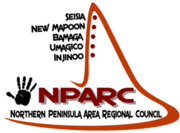History
Luthigh (also known as Lotiga, Tepiti and Uradhi, see also Uradhi related languages) is an Australian Aboriginal language spoken by the Luthigh people. The traditional language area for Luthigh includes landscape within the local government boundaries of the Cook Shire: Eastern Cape York, Ducie River, Northern Peninsula, New Mapoon, Injinoo, and Cowal Creek. [3]
Uradhi (also known as Anggamudi, Ankamuti, Atampaya, Bawtjathi, and Lotiga) is an Australian Aboriginal language of the Western Cape York Peninsula. The traditional language region includes north of Mapoon and Duyfken Point and east of the coast strip to the north of Port Musgrave (Angkamuthi country) incorporating the mouth of the Ducie River, the lower reaches of the Dulhunty River and the upper reaches of the Skardon River in the north. Following the displacement of Indigenous people by British settlement, it was also spoken in the Northern Peninsula Area Region including the communities of New Mapoon, Injinoo and Cowal Creek. [4]
The Region was created on 15 March 2008 from five previous entities—the Bamaga and Seisia Island Councils, and the Injinoo, New Mapoon and Umagico Aboriginal Councils. Its first election was held on the same day. [5]
In 1984, the Community Services (Torres Strait) Act and Community Services (Aborigines) Act were enacted by the Queensland Government, allowing community councils to be created to own and administer former reserves or missions under a Deed of Grant in Trust (DOGIT). [6] Each was responsible for local basic utilities and services such as electricity, housing and management of local CDEP programs. They also worked with the Queensland Police to provide for community police officers—hence extending well beyond the normal functions of local government. [7] The Local Government (Community Government Areas) Act 2004 extended to community councils many of the provisions and benefits of the Local Government Act 1993 normally enjoyed by shire councils.
In 2006, the councils were involved in a consultation process which resulted in a Green Paper being produced. The State Government subsequently took over the process, and in April 2007, a White Paper entitled "Community Government in the Torres Strait: the way forward" was released, recommending both governance and structural changes to ensure the sustainability of governance in the region. The White Paper expressed concerns about workload and capacity to meet community needs, deficiencies in corporate governance and accountability and other challenges and issues. The Local Government Reform report in July 2007 recommended the creation of the Northern Peninsula Area council as well as the Torres Strait Island Region council to attempt to address these issues. The Queensland Government responded by proposing the Local Government and Other Legislation (Indigenous Regional Councils) Amendment Bill 2007 to bring the two new councils into line with the recommendations of both reports. [8]
Because of the unique structure of the DOGIT areas, where a community owned the land and the council represented the community owners, concerns were raised by the councils about ownership potentially transferring to the new entities and diluting their title over it. Some councils responded by creating a private company with all community members as shareholders, and transferring the ownership to the company. This was opposed by the State Government who threatened to take legal action against the communities.
Following the elections, the Department of Local Government provided $675,000 to the Regional Council to assist with expenses relating to the post-amalgamation transfer process. [9]
Gudang (Gootung) is one of the languages of the tip of Cape York. The Gudang language region includes the landscape within the local government boundaries of the Northern Peninsula Area Regional Council, particularly the localities of Somerset, Albany Island and Newcastle Bay extending north to the Tip. [10]
Libraries
The Northern Peninsula Area Regional Council operate Indigenous Knowledge Centres at Bamaga, Injinoo, New Mapoon, Seisia and Umagico. [27]
Seisia Indigenous Knowledge Centre (IKC) opened on 2 September 2005, a time when IKCs across the state began embracing innovative technology-based literacy programs. Programs included Have you Heard, a listening station for audiobooks that could accommodate multiple users at one time, and I Can Sing, I Can Read, a program harnessing the fun and popularity of karaoke. Establishing the IKC while technology-based programs were flourishing had a lasting impact. Today, Northern Peninsula Area Regional Council positions the IKC as a technology hub for the region. This evolution was no accident and is thanks to the passion of successive IKC staff advocating for the digital needs of Seisia residents. [28]
This page is based on this
Wikipedia article Text is available under the
CC BY-SA 4.0 license; additional terms may apply.
Images, videos and audio are available under their respective licenses.

